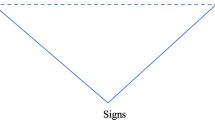Abstract
In response to Stetsenko’s [2008, Cultural Studies of Science Education, 3] call for a more unified approach in sociocultural perspectives, this paper traces the origins of the use of sociocultural ideas in New Zealand from the 1970s to the present. Of those New Zealanders working from a sociocultural perspective who responded to our query most had encountered these ideas while overseas. More recently activity theory has been of interest and used in reports of work in early childhood, workplace change in the apple industry, and in-service teacher education. In all these projects the use of activity theory has been useful for understanding how the elements of a system can transform the activity. We end by agreeing with Stetsenko that there needs to be a more concerted approach by those working from a sociocultural perspective to recognise the contribution of others in the field.
Similar content being viewed by others
Notes
Our gratitude to Lise Bird (now Claiborne), Margie Hohepa, Stuart McNaughton, Helen May, Anne Smith and Pania Te Maro.
The information on the In-service Teacher Education Practice (INSTEP) project has been drawn from the project brochure (www.minedu.govt.nz/goto/instep) and the ongoing work of the project.
References
Bird, L., & Drewery, W. (2000). Human development in Aotearoa: A journey through life. Auckland: McGraw-Hill.
Engeström, Y. (1999). Innovative learning in work teams: Analyzing cycles of knowledge creation in practice. In Y. Engeström, R. Miettinen, & R.-L. Punamäki (Eds.), Perspectives on activity theory (pp. 377–404). Cambridge: Cambridge University Press.
Engeström, Y., Miettinen, R., & Punamäki, R.-L. (1999). Perspectives on activity theory. Cambridge: Cambridge University Press.
Higgins, J. (2005). Pedagogy of facilitation: How do we best help teachers of mathematics with new practices? In H. Chick & J. Vincent (Eds.), Proceedings of the 29th annual conference of the international group for the psychology of mathematics education (Vol. 3, pp. 137–144). Melbourne: PME.
Hill, R., Capper, P., Wilson, K., Whatman, R., & Wong, K. (2007). Workplace learning in the New Zealand apple industry network: A new co-design method for government “practice making”. Journal of Workplace Learning, 19(6), 359–376.
Hohepa, M., McNaughton, S., & Jenkins, K. (1996). Māori pedagogies and the roles of the individual. New Zealand Journal of Educational Studies, 31(1), 29–40.
McDonald, G., & Kidman, J. (1991). Ten days in new entrant classrooms. New Zealand Council for Educational Research. Set 2, Item 14.
McDonald, G., Le, H., Higgins, J., & Podmore, V. (2005). Artifacts, tools, and classrooms. Mind, Culture, and Activity, 12(2), 113–127.
McNaughton, S. (1995). Patterns of emergent literacy: Processes of development and transition. Melbourne, Auckland: Oxford University Press.
Ministry of Education (1993). Te Whāriki: Draft guidelines for developmentally appropriate programmes in early childhood services. Wellington: Learning Media.
Panckhurst, F. (1989). The acquisition of cartography in preschool children. Unpublished PhD thesis, Victoria University of Wellington.
Ramsay, K., Breen, J., Sturm, J., Lee, W., & Carr, M. (2006). Strengthening learning and teaching using ICT. Roskill South Kindergarten Centre of Innovation 2003–2006. Hamilton: Wilf Malcolm Institute of Educational Research, University of Waikato.
Roth, W.-M., & Tobin, K. (2002). Redesigning an “urban” teacher education program: An activity theory perspective. Mind, Culture, and Activity, 9(2), 108–131.
Smith, A. B. (1982). Understanding children’s development. Sydney: Allen & Unwin.
Smith, A. B. (1988). Understanding children’s development: A New Zealand perspective (2nd ed.). With a chapter by Keith D. Ballard. Wellington: Allen & Unwin/Port Nicholson Press.
Smith, A. B. (1992). Understanding children’s development: A New Zealand perspective (3rd ed.). Auckland: Bridget Williams Books.
Vygotsky, L. S. (1962). Thought and language (trans: Hanfmann, E. & Vakar, G. (Eds.)). Cambridge, MA: MIT Press.
Vygotsky, L. S. (1978). In M. Cole, V. John-Steiner, S. Scribner, & E. Souberman (Eds.), Mind in society. The development of higher psychological processes. Cambridge, MA: Harvard University Press.
Vygotsky, L. S. (1987). The collected works of L.S. Vygotsky: Problems of general psychology, Volume 1. New York: Plenum Press.
Author information
Authors and Affiliations
Corresponding author
Rights and permissions
About this article
Cite this article
Higgins, J., McDonald, G. Cultural studies of science education. Cult Stud of Sci Educ 3, 507–515 (2008). https://doi.org/10.1007/s11422-008-9110-4
Received:
Accepted:
Published:
Issue Date:
DOI: https://doi.org/10.1007/s11422-008-9110-4




